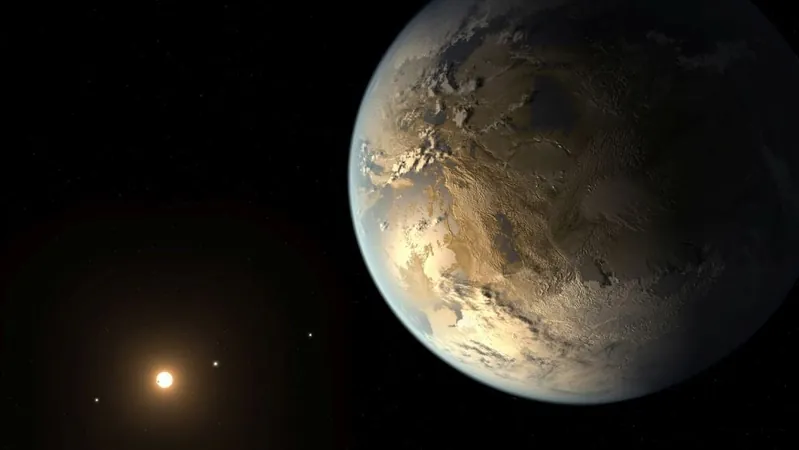
Why Civilization Needs Plate Tectonics: The Key to Long-Term Habitability
2025-09-15
Author: Daniel
The Connection Between Plate Tectonics and Civilization
Plate tectonics might not be crucial for life itself, but they're essential for the birth of a technological civilization. While life could potentially thrive on a static planet, that survival may be fleeting. Without the dynamic processes of plate tectonics, a planet's ability to maintain a stable climate over eons is drastically diminished, leading to catastrophic levels of atmospheric carbon dioxide.
Revolutionary Research Unveils Cosmic Insights
A groundbreaking study presented at recent scientific gatherings, including the Europlanet Science Congress, reveals that plate tectonics are vital for the long-term habitability of planets. Researchers suggest that our fruitless searches for advanced civilizations may stem from the rarity of Earth-like planets with tectonic activity and balanced carbon-silicate cycles. While many planets can support temporary life, sustaining conditions for a thriving civilization like ours is another matter entirely.
Understanding Earth-like Habitats in the Milky Way
The study is built on papers published in the journal *Astrobiology*, notably by Helmut Lammer and Manuel Scherf, both from the Austrian Academy of Sciences. These scholars propose a formula to estimate the number of Earth-like habitats (EH) capable of fostering complex, intelligent life. Their definition of EH includes rocky exoplanets situated in the habitable zone, featuring atmospheres dominated by nitrogen and oxygen with trace amounts of carbon dioxide.
How Carbon Dioxide Shapes a Planet's Future
Carbon dioxide is at the core of these discussions. Generally, a higher concentration of CO2 allows a planet to maintain habitability longer. However, a delicate balance is crucial; excessive CO2 can lead to a runaway greenhouse effect, making the planet increasingly uninhabitable. Earth benefits from plate tectonics, which helps regulate carbon levels through a constant carbon-silicate cycle, ensuring that CO2 does not build up to damaging heights.
The Implications of a Dwindling Atmosphere
Yet, the research also warns of a downside. According to Scherf, if enough CO2 is drawn from the atmosphere, photosynthesis will cease, potentially occurring within the next few hundred million years. This emphasizes the importance of a balanced atmospheric composition for sustaining life.
A Rare Opportunity for Technological Civilizations
The combined findings of these studies highlight that Earth-like environments capable of giving rise to technological civilizations are exceedingly rare. It could take anywhere from 1,000 to 1,000,000 rocky exoplanets in the habitable zone to nurture a single EH like Earth. Their calculations to gauge the existence of another civilization alongside ours concluded that a planet with at least 10% carbon dioxide in its atmosphere would need to support its technological life for about 280,000 years to coexist with humanity.
Seeking Extraterrestrial Intelligence
The researchers even attempted to estimate the nearest extraterrestrial intelligences (ETIs), suggesting they might be around 33,000 light-years away, almost on the opposite edge of our galaxy. This startling distance presents huge challenges for any form of interstellar communication or travel.
The Great Filter: Why Aren't We Finding E.T.?
This fascinating research introduces a concept known as the 'Great Filter,' which ponders why we haven't yet encountered any ETIs. One possibility is that civilizations struggle to advance to an interstellar stage, constrained either by insurmountable distances or self-destructive tendencies.
A Future of Possibilities
As our technology progresses, we may glean more insights into the atmospheres of distant rocky exoplanets. The hunt for extraterrestrial intelligence remains a crucial frontier. Scherf emphasizes, “If searches yield nothing, it strengthens our hypothesis. However, if SETI discovers something, it would mark one of the most monumental breakthroughs in human history, confirming we are not alone in this vast universe.”

 Brasil (PT)
Brasil (PT)
 Canada (EN)
Canada (EN)
 Chile (ES)
Chile (ES)
 Česko (CS)
Česko (CS)
 대한민국 (KO)
대한민국 (KO)
 España (ES)
España (ES)
 France (FR)
France (FR)
 Hong Kong (EN)
Hong Kong (EN)
 Italia (IT)
Italia (IT)
 日本 (JA)
日本 (JA)
 Magyarország (HU)
Magyarország (HU)
 Norge (NO)
Norge (NO)
 Polska (PL)
Polska (PL)
 Schweiz (DE)
Schweiz (DE)
 Singapore (EN)
Singapore (EN)
 Sverige (SV)
Sverige (SV)
 Suomi (FI)
Suomi (FI)
 Türkiye (TR)
Türkiye (TR)
 الإمارات العربية المتحدة (AR)
الإمارات العربية المتحدة (AR)